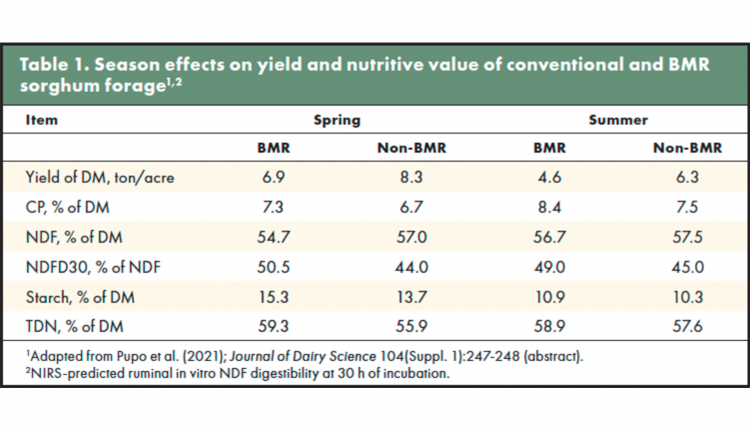Make sorghum silage the best it can be |
| By Luiz Ferraretto |
|
|
|
The author is an assistant professor and ruminant nutrition extension specialist at the University of Wisconsin-Madison. Sorghum is a key forage source for dairy herds in many areas across the United States with dry climates. But it has also been successfully grown under more humid conditions. Key benefits such as water use efficiency, flexibility for delayed planting, and greater tolerance to drought conditions, diseases, and pathogens compared to corn offer multiple opportunities for forage growers and dairy producers. Besides, the lower cost of production makes sorghum silage very appealing across a wide variety of conditions, especially for dairy heifers. A potential drawback of sorghum silage for diet formulation is the greater neutral detergent fiber (NDF), acid detergent fiber (ADF), and lignin concentrations combined with reduced starch concentration compared to corn silage. Many important decisions affecting the nutritive value and yield of sorghum silage can be made to diminish these issues. Pick the right hybrids Carefully selecting for hybrids with genetic advances ensures good nutritive value at the time of harvest. As with other crops, sorghum hybrids expressing the brown midrib (BMR) trait are possibly the best example of how nutritive value can be improved through genetic advancement. We conducted a retrospective study using data from sorghum forage grown in Florida from 2008 to 2019 to study these potential benefits. Our main findings are summarized in Table 1. Sorghum plants with the BMR trait have reduced lignin concentration and greater fiber digestibility compared to non-BMR plants. But this benefit is more evident for spring (+6.5 percentage units) compared to summer (+4 percentage units) planting.  Yield drags are more challenging when planting BMR sorghum under stressful environmental conditions. Tonnage of BMR sorghum hybrids was 83% of the yield of conventional hybrids in the spring but only 73% in the summer. Lower yields may be offset by the improved animal performance from BMR hybrids, but the magnitude of these responses may vary from farm-to-farm. Feeding BMR sorghum silage-based diets improved intake (+1.8 pounds per day), milk production (+3.6 pounds per day), and milkfat concentration (+0.09 percentage units) of dairy cows compared to feeding conventional sorghum, according to a recent meta-analysis review of the literature. No differences in intake and milk yield were observed when BMR sorghum silage was compared to conventional corn hybrids. Having reduced yield but greater daily feeding rates when planting BMR hybrids requires planning and watching forage inventories closely. Lodging was a perceived problem for some BMR sorghum hybrids, particularly when sown at high seeding rates, but our preliminary analysis of data from this retrospective study suggest newer hybrids are less susceptible to lodging with similar lodging scores to conventional hybrids. Time it right Defining the targeted maturity for forage harvesting requires finding the optimum combination between yield and nutritive value. The “sweet spot” will be unique and dependent upon goals and conditions of each farm. Sorghum grains mature from milk stage to soft dough to hard dough to physiological maturity over a 25- to 45-day period after flowering, depending upon the hybrid and climate. The timing of harvest within this window is critical to capture the desired nutrient value. Timing the BMR sorghum silage harvest to maximize yield and nutritional value was the focus of a recent study. Seven field trials across two locations in New York were performed. Harvests at each location targeted boot, flower, milk, and soft dough stages. A summary of this study’s main findings is in Table 2. Later harvest stages maximized yield and starch concentration at the expense of crude protein (CP) concentration and fiber digestibility.  A modeling exercise was conducted by replacing gradual levels of corn silage of a basal diet with each of these sorghum silages. Authors concluded sorghum silage would require some energy supplementation adjustments to maintain the same energy density. The latest sorghum harvest had the greatest potential to replace corn silage, which was likely driven by its greater starch concentration. In eras of high corn prices, harvesting sorghum silage later to optimize yield and starch concentration becomes appealing. Delaying harvest requires proper chop length settings and packing management to ensure adequate fermentation. Challenges remain Formulating diets, keeping in mind the reduced starch concentration of sorghum silage compared to corn silage, is key. Like the corn kernel, sorghum grain must be broken down for starch to be accessible for digestion or grain will bypass the digestive tract virtually intact. As with other small-seeded silages, losing grain in the feces is a common issue for dairies harvesting sorghum. Aggressive mechanical processing is a widespread practice for obliterating corn kernels. The same must be true for sorghum as well, but research addressing this issue with sorghum silage is very limited. We processed sorghum plants grown in Florida with a forage harvester to achieve combinations of two roll gap (1 or 3 millimeter [mm)]) and two chop length (15 or 22 mm) settings. Processor settings used were representative of industry standards in the production of corn silage. It is reasonable to assume similar on-board processor and knife settings are used for sorghum silage harvesting. Aggressive processor settings increased the proportion of sorghum grain passing through a 2.36 mm sieve. This sieve represents sorghum grain broken in two or more pieces. However, very few samples reached 50% of starch passing through this sieve, and in situ starch digestibility values were very low even after 90 days of fermentation. These results are alarming and suggest more aggressive processors and/or settings are required. But further reductions of roll gap in a forage harvester would slow harvest, reduce throughput, boost fuel costs, and wear on grain processing rollers. Future developments targeting this issue are needed. This article appeared in the November 2021 issue of Hay & Forage Grower on pages 20 and 21. Not a subscriber? Click to get the print magazine. |
